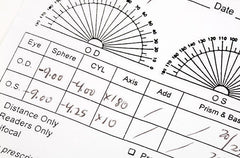What You Must Know Colored Contacts For Astigmatism
According to the Oxford dictionary, the word ‘toric’ is defined as having the form of a torus or part of a torus. When the word toric is added to a contact lens, it has two different curves instead of one. Toric contact lens is used to correct both astigmatism and short- or long-sightedness. Toric contact lens is also know as contacts for astigmatism. While colored contacts for astigmatism is color version for contacts for astigmatism.
When someone has astigmatism issues, the cornea is curved. Therefore, the refraction of your eye differs between the vertical and horizontal planes. This leads to light hitting your retina in a way that does not create a clear image of the world. If you have astigmatism, your cornea is shaped in a more oblong fashion, like a rugby ball, instead of a circle as it is supposed to be. This causes blurry vision and trouble seeing fine details. At night when looking at lights, they appear to bounce off their primary location.
This irregularity results in blurry or distorted vision that forces you to strain your eyes to see things more clearly. Frequent straining or squinting due to poor vision can overwork your eye muscles, triggering headaches and tired eyes. If this issue is not corrected properly, you can suffer from eye strain, discomfort and even have troubles driving at night.
What are the features of a toric lens?
A standard contact lens has a spherical surface like a beach ball but sliced in half. Toric contact lens on the other hand, is shaped like a slice of the side of a doughnut – more elongated. This special shape of toric contact lens creates different refractive, focus and powers on the vertical and horizontal orientations, unlike a standard lens. The refractive strength then gradually increases or decreases as you move around the lens.
Today, contacts for astigmatism comes in soft contacts too, which are more gas permeable than hard contacts. Even though hard contacts have been the preferred treatment for astigmatism and helped reshape the eye for many years, recent research has shown that soft contacts allow for better long-term eye health.
These soft toric contact lenses use specific meridians to stay in place and improve your visual acuity. Meridians are measured from your pupil out, like a radius in a circle. These meridians are measured to specific powers to correct your astigmatism.
Do I qualify for colored contacts for astigmatism?
Genetics being the big factor, there are no known causes of astigmatism so far. However, it is quite common for people to have astigmatism in addition to other refractive errors like nearsightedness or farsightedness. People who treat one refractive error most of the time wear soft contacts that do not treat their astigmatism issues and have to suffer from this defect. If you have issues with nearsightedness or farsightedness and suffer from astigmatism, toric lens may be the solution to correct the corneal shape while also correcting other refractive errors.
Astigmatism can happen to children and adults. The condition is usually present at birth and may develop later in life. People who have high risk of developing astigmatism are:
- Have a family history of astigmatism or eye disorders (e.g keratoconus)
- Scarring of your cornea
- Extreme nearsightedness or farsightedness
- Prior history of eye surgery (e.g cataract surgery)
Stock image by freepik
Getting a contacts for astigmatism
Read More: Toric Contacts: What is Cylindrical Power?
Stay in style with colored contacts for astigmatism
Proper cleaning and handling of yourcontact lens isimportant to keep your eyes healthy.
 Skip to content
Skip to content



